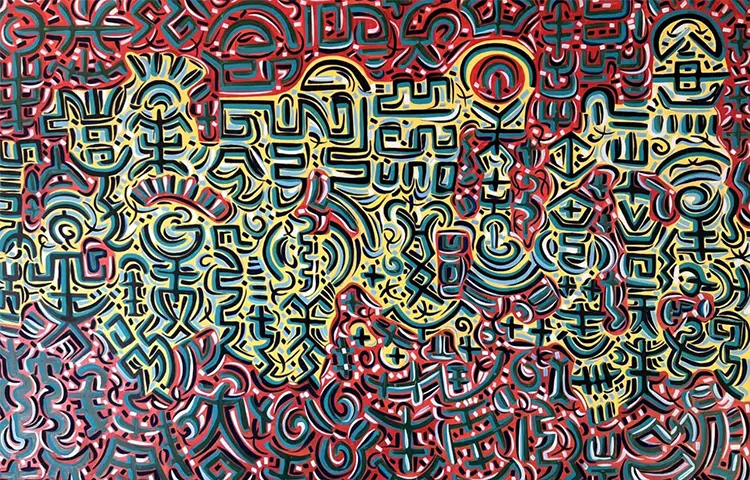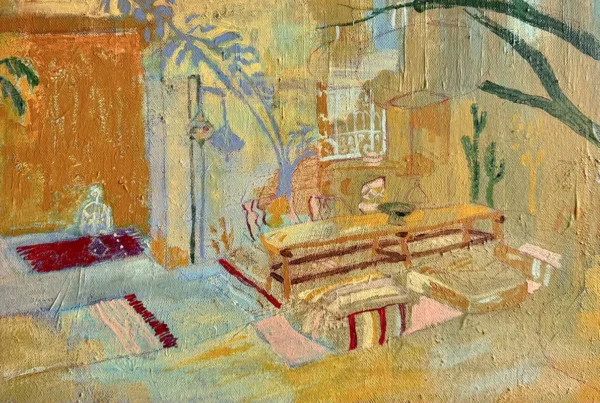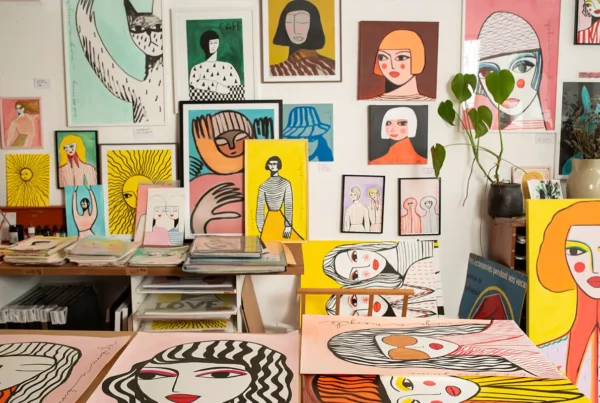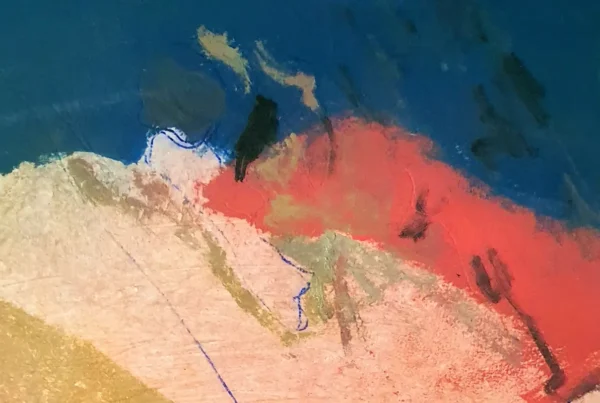“My art is a bridge between the ‘seen’ and ‘unseen’ worlds.”
The Artist Shaped by SoHo’s Pulse
Creativity has always been more than just an inclination for Mieshiel—it has been the defining current of his life since early childhood. Born in 1964 amidst the vibrant artistic landscape of New York City, Mieshiel was immersed from the beginning in an environment where art was not only appreciated but lived. Raised by parents who balanced careers in graphic design with their passions as fine artists, he absorbed the rhythms of artistic discipline alongside the freedom of experimental expression. Growing up in the heart of SoHo during the transformative decades of the 1970s and 1980s, he witnessed firsthand the groundbreaking innovations of the contemporary art scene, experiences that deeply shaped his own creative instincts.
The influence of this artistic upbringing provided Mieshiel with more than exposure; it offered a sense of inevitability regarding his path. With unwavering support from his family, he recognized early on that no other vocation stirred his spirit in quite the same way. The array of media and styles explored by his parents encouraged him to engage with art on multiple levels, fostering an appreciation for both technical skill and visionary daring. This early immersion set the stage for his future explorations, where artistic practice would become not just a career, but a lifelong devotion.
Determined to refine his craft, Mieshiel took the next significant step by enrolling at the California Institute of the Arts (CalArts), a decision that broadened his artistic vocabulary while challenging him to push boundaries. Though his formal studies concentrated on graphic design, the creative environment of CalArts nurtured his abilities as a fine artist. Here, he ventured deeper into painting, drawing, and printmaking, forging a hybrid approach that blended structured design principles with the expressive freedom of fine art. This synthesis of East Coast sophistication and West Coast audacity continues to underpin his artistic identity.

Circus Circus
Oil on canvas
72”x108”
Mieshiel: Art as Spiritual Journey
Throughout his career, Mieshiel has sought to create more than visual artifacts; his work serves as an invitation into expanded perception and inner reflection. His distinctive approach, which he describes as a fusion of impressionism, surrealism, and what he calls “shamanic vision,” is marked by intricate compositions layered with symbolic language and otherworldly imagery. This artistic philosophy draws heavily on his own experiences of dreams, visions, and spiritual inquiry, often exploring the liminal spaces where consciousness blurs between the tangible and the transcendent. His goal is not merely to depict scenes, but to activate the viewer’s imagination and intuition, encouraging a deeper engagement with the unseen dimensions of reality.
Among Mieshiel’s most profound achievements is Heaven’s Gate, a monumental colored-pencil work that spans ten by fifteen feet across nine panels. Created between 2003 and 2006, this piece stands as a cornerstone of his artistic legacy. The work serves as a visual meditation on the interconnectedness of earthly and celestial planes, embodying his fascination with sacred symbolism and spiritual storytelling. With meticulous attention to detail, Heaven’s Gate represents what he considers his greatest work to date, encapsulating his commitment to creating art that resonates on both emotional and metaphysical levels.
Although Mieshiel has since shifted his primary focus toward large-scale oil painting, his colored-pencil drawings continue to hold a significant place in his body of work. His earlier pieces, often described as “impressionist surrealism,” remain celebrated for their elaborate intricacy and symbolic depth. The transition from these finely detailed works to bolder, more expansive paintings reflects his ongoing evolution as an artist—a journey marked by both continuity and transformation. Through every medium he explores, Mieshiel remains committed to art as a vessel for awakening and connection.
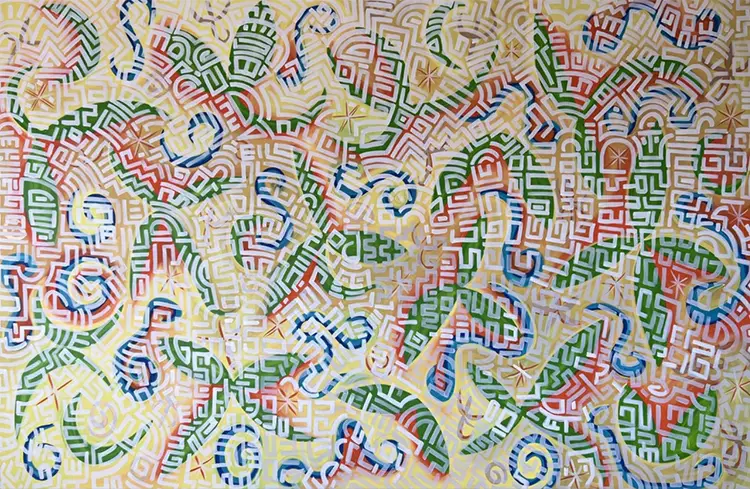
Beyond the Veil
Oil on canvas
72”x108”
Where the Desert Meets the Canvas
Since 1987, Mieshiel has called the high desert of Taos, New Mexico, home—a choice that profoundly influences the tone and spirit of his art. Living off the grid in a solar- and wind-powered home he designed and built himself, he has embraced a lifestyle aligned with self-sufficiency and deep connection to the natural world. The solitude and expansiveness of this desert landscape provide not only physical space but also psychological clarity, allowing him to engage fully with his creative process free from the distractions of urban life. The rugged terrain and shifting skies of New Mexico echo through his work, lending it a sense of spaciousness and elemental force.
This environment offers more than scenic inspiration; it has become integral to Mieshiel’s artistic practice. Away from the noise of city life, he finds the quiet necessary to access inner landscapes, channeling the rhythms of nature into his visual language. The isolation serves as a fertile ground for introspection, helping him to cultivate the spiritual dimensions that characterize his art. Within this setting, Mieshiel is able to continuously refine his vision, crafting pieces that speak to both personal journey and universal themes of transformation and transcendence.
Recently, the artist has realized a long-held dream: the construction of his ideal studio space, designed to accommodate large-scale paintings that extend up to nine feet in height. This expanded workspace has opened new avenues for creative exploration, allowing him to fully embrace the grandeur and boldness that his current artistic direction demands. Yet despite the scale, he remains equally dedicated to smaller canvases, maintaining a dynamic range in his output that mirrors the dualities of vastness and intimacy present in his surroundings.
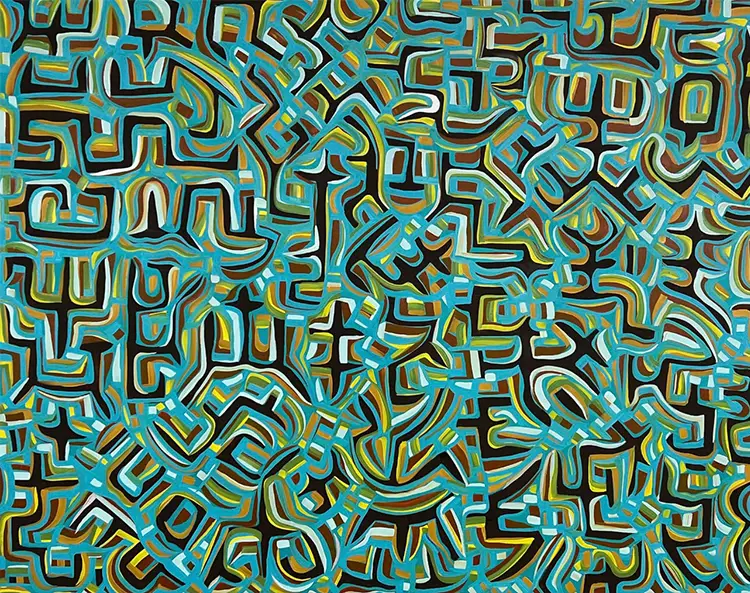
Plant Medicine
Oil on canvas
48”x60”
Mieshiel: Bridging Vision and Form
Mieshiel’s artistic influences reflect a reverence for both historical innovation and contemporary audacity. He cites modernist luminaries such as Picasso, Miró, Matisse, and Gorky as foundational to his aesthetic development, their pioneering approaches to form and color echoing in his work. At the same time, the visceral energy of artists like Keith Haring, Jean-Michel Basquiat, and Kenny Scharf contributes to the dynamism and immediacy of his visual language. This blend of artistic lineage underscores Mieshiel’s commitment to honoring tradition while forging new paths of expression.
Beyond the canvas, Mieshiel’s art has found life across diverse mediums, from giclée and block prints to wearable textiles. This expansion of format reflects his belief that art should not remain confined to gallery walls but should become part of everyday experience. By translating his vivid, graphic patterns and bright, flowing shapes into fabric and print, he invites audiences to engage with his work in more intimate, tactile ways. These alternative presentations allow his visual narratives to circulate through broader communities, fostering daily encounters with creativity and beauty.
Looking toward the future, Mieshiel envisions his large-scale paintings occupying public spaces, both indoors and outdoors, with aspirations of seeing them replicated on building facades. His ongoing projects continue to explore the interplay between sound, image, and frequency, deepening his exploration of immersive artistic experiences. Whether through monumental oil works, detailed pencil drawings, or interactive installations, Mieshiel remains devoted to his mission: to enrich and expand the viewer’s perception, inviting all who encounter his art to step into a space where the visible and the invisible meet.
